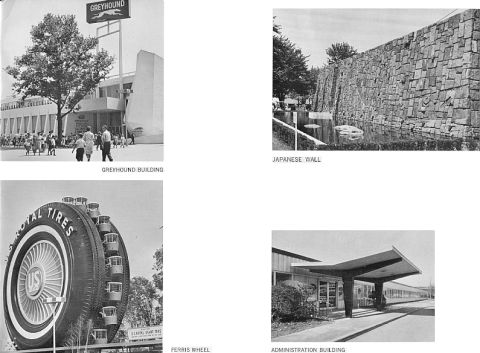|
|
"It is a
source of regret to us that the Fair can not complete this great
park so that nothing further will be required for many years.
Every step we are taking however, follows an ultimate plan which
is realizable in the not distant future ... We believe it is
no exaggeration to say that two World's Fairs have produced here
in the very center of New York, on the scene of a notorious ash
dump, one of the very great municipal parks of our country."
Robert Moses
Post-Fair Engineering
Report ... Flushing Meadow
July 23, 1965
|
As the Post-Fair Engineering Report
... Flushing Meadow was put to press, the 1964/1965 New York
World's Fair was struggling toward its conclusion. Over-estimation
of attendance and reckless spending had nearly pushed the Fair
into bankruptcy. It wasn't until the month of October that New
Yorkers began to realize that their World's Fair was about to
disappear from Flushing Meadow forever. If they were going to
see it they'd better get out there soon! Record attendance during
the last month of the Fair saved it from bankruptcy.
The Fair was temporary. Flushing Meadow
Park was permanent. The infrastructure created for the Fair was
put in place with the park in mind so that money spent would
be of lasting benefit. But what of the "glorious nightmare"
that had been the Fair's many pavilions? What could be salvaged
from the exhibitors?
|
Inherent in the
design and construction of the Post-Fair Park is the question
of what buildings and structures should be retained for City
Park use and related purposes. In this connection the Fair Corporation's
planning for the Post-Fair Park has been based on the premise
that buildings not useful for Park or closely related purposes
do not belong in Flushing Meadow unless they are on the periphery
reached independently of the Park interior road and path system.
A further important
consideration is that if an exhibitor's building is to be converted
for permanent use, funds for the conversion should be provided
by the exhibitor, up to the amount he would otherwise be required
to spend for demolition, with any additional funds being provided
by a source other than the Fair Corporation.
The 1964-1965
Fair produced some exceptionally artistic pavilions and there
have been many suggestions that some of them be kept permanently
in the Park. However, these pavilions were built under a special
Building Code as temporary special purpose structures and in
almost all cases, conversion for permanent use would be prohibitively
expensive and would serve no useful Park purpose.
Post-Fair Engineering
Report ... Flushing Meadow
July 23, 1965
|
"The Mayor's Committee," appointed
by Mayor Wagner in February, 1965 to determine what should remain
of the Fair, dutifully followed their instructions and chose
to recommend only a handful:
- PERMANENT BUILDINGS FROM THE 1939-1940
WORLD'S FAIR
- The City Building
- The State Amphitheater
- The Boathouse
- BUILDINGS BUILT BY THE CITY OR FAIR
FOR THE 1964-1965 WORLD'S FAIR
- The Hall of Science
- The Administration Building
of the Queens Botanical Garden
- The Singer Bowl
- The Administration Building
- The Post Office Building
- The Entrance Building
- The Maintenance Building
- The Press Building
- BUILDINGS BUILT BY EXHIBITORS
- The Unisphere
- The Heliport
- The World's Fair Marina
- The New York State Building
- The Greyhound Building
- The Ferris Wheel
- The Japanese Wall

|
Exhibitors are
responsible for demolition of their structures which they are
required to remove to at least four feet below finished grade
and restore the site to finished grade. Topsoil on the exhibitor's
lot must be retained and replaced on the site following demolition.
Planting of trees and shrubs suitable for use in the park will,
so far as practicable, remain as permanent planting either in
their present positions or on more suitable sites.
The Fair is responsible
for demolition of all buildings, structures and appurtenances
built or operated by the Fair Corporation which will not be retained
in the Park. The demolition requirements for these structures
are the same as for exhibitor buildings.
After demolition
is completed, the disturbed areas will be top soiled, seeded
and appropriately planted. These areas, for both passive and
active recreational use, will be served by tree-lined walks for
pedestrian and bicycle use. Many of the trees planted for the
1939-1940 Fair were saved and incorporated in the road and path
systems of the 1964-1965 Fair, and thousands of new trees were
planted for the 1964-1965 Fair along streets and paths and in
open areas.
The preparation
of plans for the removal, demolition and salvage operations will
be completed by October 1, 1965, and exhibit removal and demolition
operations will begin by November 1, 1965. By October, 1966,
the Park Restoration will be substantially completed. On January
1, 1967, all work for which funds are available will be completed.
Post-Fair Engineering
Report ... Flushing Meadow
July 23, 1965
|
|